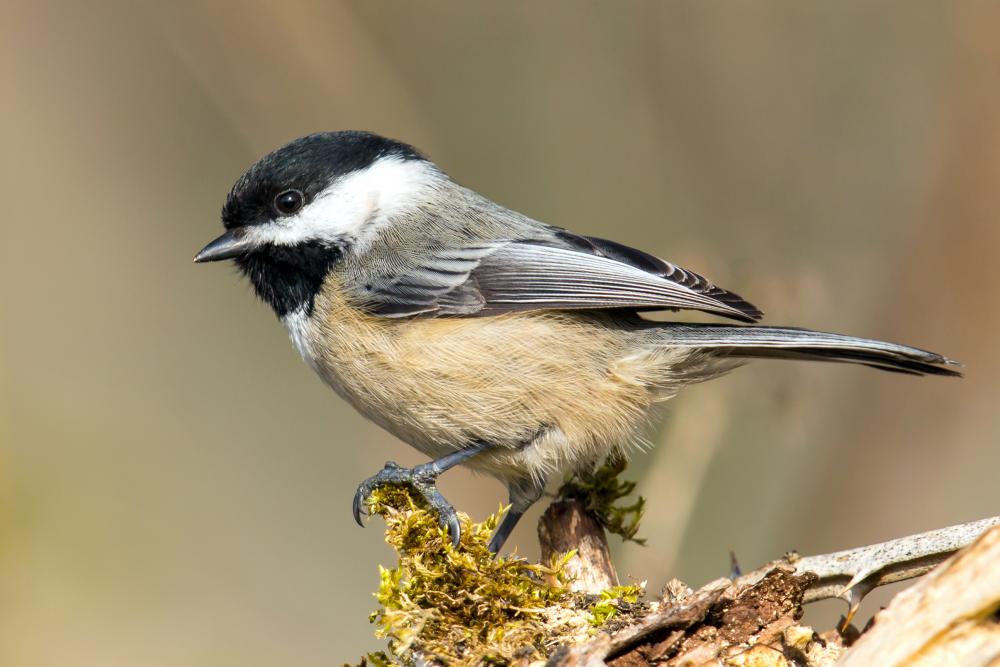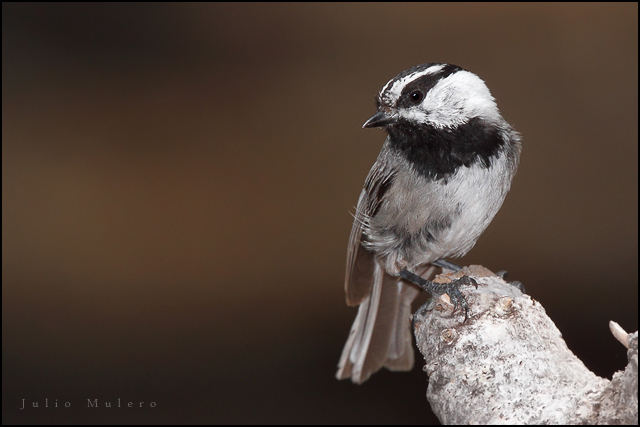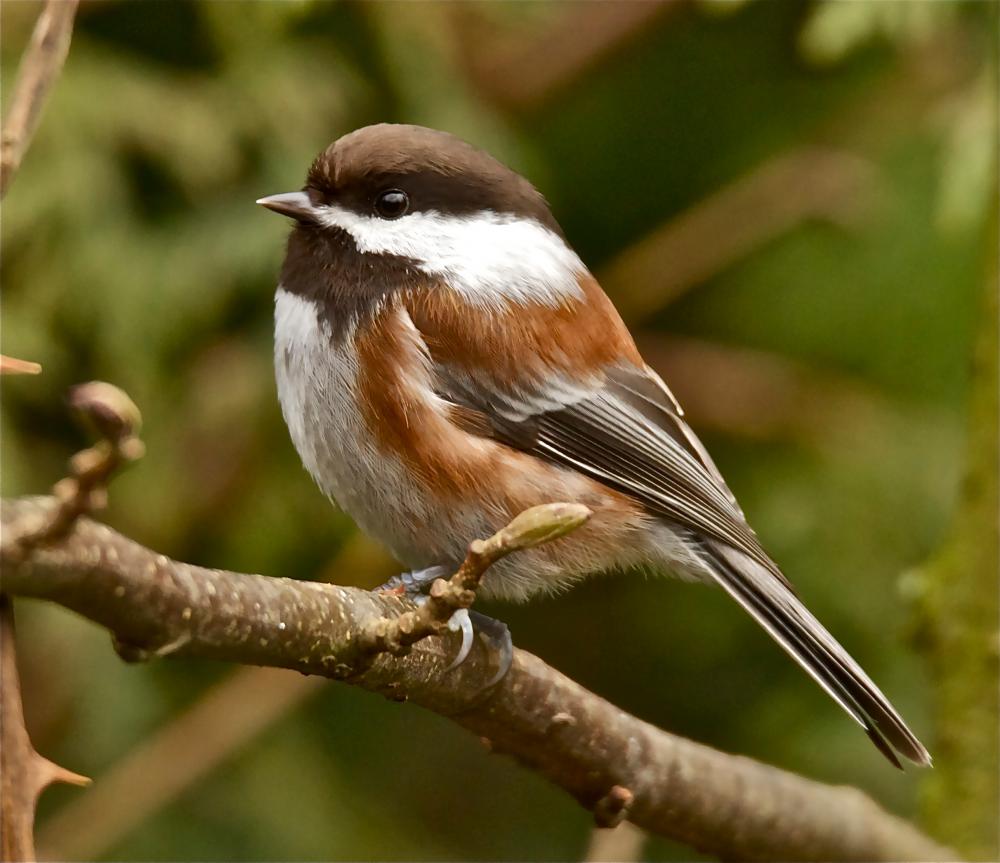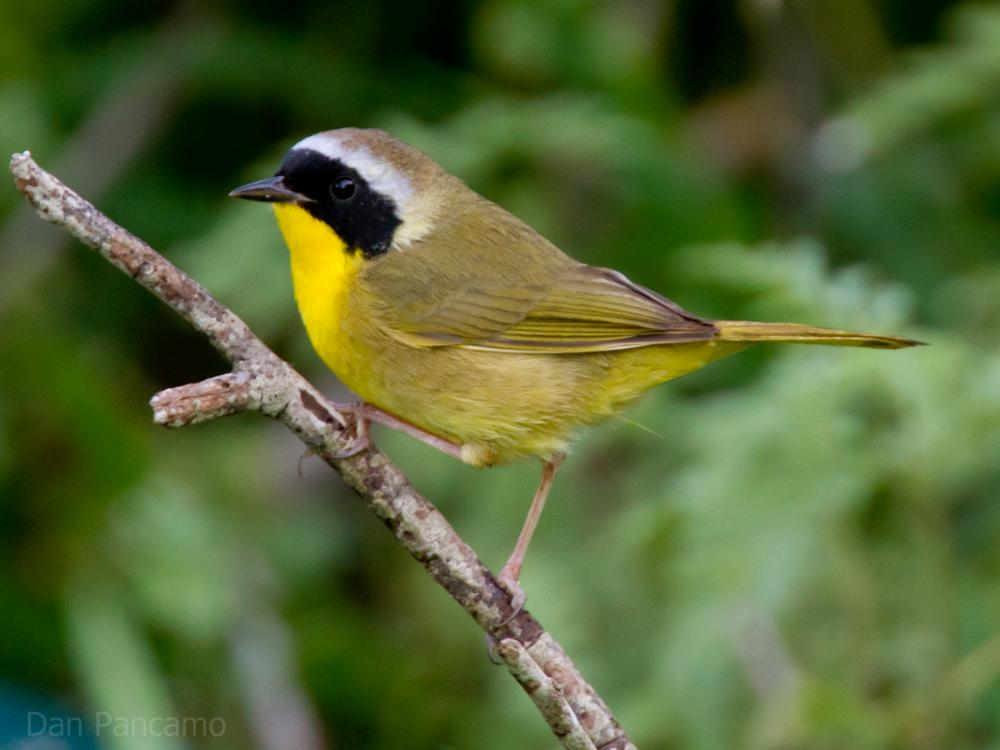eOrganic authors:
Olivia M. Smith, School of Biological Sciences, Washington State University
William E. Snyder Ph.D., Department of Entomology, Washington State University
This is one in a series of three articles about insectivorous birds on organic farms. The other articles are:
Introduction
A growing body of experimental evidence suggests that birds play important roles as natural enemies in agricultural ecosystems. For example, a study conducted in Europe demonstrated the important services provided by Great Tits (Parus major) in apple orchards. Researchers experimentally added nest boxes to some plots and saw an increase in fruit yield from 4.7 to 7.8 kg per tree. Increased yield was attributed to predation of caterpillars by Great Tits (Mols et al., 2002). A review paper by Bael et al. (2008) found that across 48 studies examined, birds reduced arthropods and plant damage. Here we focus on identification, diet, and management of chickadees and warblers observed on West Coast vegetable farms and discuss their natural pest control services.
Black-capped Chickadee (Poecile atricapillus)

Figure 1. Black-capped Chickadee. Photo credit: Mick Thompson, Black-capped Chickadee, CC Attribution-NonCommercial 2.0
Identification
As its common name implies, this chickadee has a black cap. It also has a black chin, white cheeks, a white breast and belly, buffy flanks, and grayish wings and tail. Chickadees have small bills. The entire length of the Black-capped Chickadee averages about 12.3–14.6 cm, and they weigh on average only 10–14 g (Fig. 1; Foote et al., 2010). The Black-capped Chickadee has complex vocal behaviors with 16 unique types of vocalizations (Smith, 1991). The whistled song is typically two clear tones with a higher-pitched fee note followed by a lower-pitched bee note. The Black-capped Chickadee also has a chick-a-dee call that is the namesake of the genus. Mountain Chickadees are similar in appearance but have an obvious white eyebrow called a supercilium, and are primarily found in higher altitude montane coniferous forests (Fig. 2; McCallum et al., 1999).

Figure 2. Mountain Chickadee. Note the prominent white eyebrow called the supercilium. Photo credit: Julio Mulero, Mountain Chickadee, CC Attribution-NonCommercial-NoDerivs 2.0
Diet
During the breeding season, the Black-capped Chickadee's diet is about 80–90% animal matter (primarily caterpillars), with the rest of the diet comprised of fruit and seeds. During the winter, the diet shifts to about 50% animal matter (primarily insects and spiders) and 50% plant matter (primarily seeds and berries) (Smith, 1991). The Black-capped Chickadee primarily forages on trees by gleaning insects off the bark and leaves, and rarely forages on the ground. Approximately 58% of arthropod prey are taken from bark and 38.2% are taken from leaves (n = 451, Robinson and Holmes, 1982). One study found that chickadees can use leaf damage cues to locate cryptic caterpillars (Heinrich and Collins, 1983). Chickadees are rarely found in vegetable fields, but are commonly found foraging in orchards. Caterpillars comprise the largest portion of the chickadee diet, with other insects, spiders, small snails, small slugs, and centipedes forming smaller components (Bent, 1946; Robinson and Holmes, 1982; Smith, 1991). The Black-capped Chickadee is known to take blueberries and blackberries as available (Foote et al., 2010).
Management
Results from the North American Breeding Bird Survey indicate a 0.59% range-wide increase from 1966-2012, but this species is declining in the Pacific Northwest (Sauer et al., 2014). The Black-capped Chickadee can be found in a wide variety of habitats as long as trees are present. Clearing trees for agriculture can create more forest edge, which is a preferred habitat for chickadees (Foote et al., 2010). Black-capped Chickadees are year-round residents, and providing supplemental food at feeders in the winter can improve survival rates (Brittingham and Temple, 1988). This species is able to excavate its own nest cavities in tree species such as birch and aspen, but can also use cavities excavated by other species (Mennill and Ratcliffe, 2004; Foote et al., 2010). Nest trees average 20.5 cm diameter at breast height (DBH) (Ramsay et al., 1999). Chickadees will nest in artificial nests when natural cavities are rare. Black-capped Chickadees are more likely to use artificial snags than nest boxes. Usage of both increase when cavities are filled with wood shavings (Cooper and Bonter, 2008). Invasive House Sparrows (Passer domesticus) can outcompete chickadees for nest cavities and boxes, so constructing boxes with entrance holes small enough to exclude House Sparrows is important (about 2.86–3.18 cm diameter). Instructions on nest construction and placement can be found here. Additionally, many businesses sell pre-made nest boxes. Instructions on deterrence and removal of House Sparrows can be found here.
Chestnut-backed Chickadee (Poecile rufescens)
Figure 3. Chestnut-backed Chickadee. Photo credit: Jerry McFarland, Chestnut-backed Chickadee, CC Attribution-NonCommercial 2.0
Identification
As its common name implies, the Chestnut-backed Chickadee has a chestnut back and flanks and a brown cap (Fig. 3). The entire length of the male Chestnut-backed Chickadee averages about 10.5–12.5 cm, while the average length of the female is about 10.0–11.4 cm. The average weight is only 8.5–12.6 g (Dahlsten et al. 2002), making it slightly smaller on average than the Black-capped Chickadee. It also lacks the whistled song present in the Black-capped Chickadee, but has a well-defined chick-a-dee call. The Chestnut-backed Chickadee's chick-a-dee call is higher, faster, shorter, and huskier than the Black-capped Chickadee's. The Chestnut-backed Chickadee is notable for its preference for coniferous forest habitat (Smith, 1991). The Chestnut-backed Chickadee tends to forage higher in trees and more often in conifers than the Black-capped Chickadee (Sturnman, 1968).
Diet
Arthropods comprise approximately 65% of the annual diet, with leafhoppers, treehoppers, scales, spiders, wasps, and caterpillar larvae among preferred food items. Seeds and plant material (fruit pulp and other miscellaneous matter) make up the remaining 35% of the diet (Beal, 1907; Dixon, 1954). Nestlings are fed caterpillars, sawfly larvae, crickets, spiders, and flies (Kleintjes and Dahlsten, 1994). Chestnut-backed Chickadees are canopy foragers, primarily foraging on leaf surfaces—unlike bark-gleaning Black-capped Chickadees—and are often found in oak, fir, or pine (Dixon, 1954; Root, 1964; Sturnman, 1968; Brennan et al., 2000). Chestnut-backed Chickadees are frequently observed foraging in fence rows with conifers and forests adjacent to farms but rarely, if ever, forage among farmed areas. Chestnut-backed Chickadees may be extremely beneficial to the forestry industry through natural pest control services (Kleintjes and Dahlsten, 1994).
Management
Results from the North American Breeding Bird Survey indicate a 1.77% range-wide decline from 1966–2012, with a similar trend of decline (1.66%) in the Pacific Northwest (Sauer et al., 2014). Nesting requirements are similar to the Black-capped Chickadee (see above). Leaving snags and adding nest boxes can encourage nesting (Dahlsten et al., 2002). Visit nestwatch for detailed nest building and placement information.
Common Yellowthroat (Geothlypis tichas)
Figure 4. Male Common Yellowthroat. Photo credit: Dan Pancamo, Common Yellowthroat, CC Attribution-ShareAlike 2.0

Figure 5. Female Common Yellowthroat. Photo Credit: John Benson, Common Yellowthroat, CC Attribution 2.0
Identification
Male and female Common Yellowthroat are sexually dimorphic, meaning they do not look the same. The male has a black mask, a yellow throat, and an olive green back, nape, wings, and tail (Fig. 4). Males have a distinct wich-i-ty wich-i-ty wich-ity song which is variable by region, but always contains the wich component. The female is mostly dull olive-gray with a dull yellow throat (Fig. 5). The female could be easily confused with other small warblers such as the Orange-crowned Warbler or Nashville Warbler. The female is also similar to female American and Lesser Goldfinches, but warbler bills are less stocky and the Common Yellowthroat lacks the distinct wing bars present in the goldfinches. The entire length of the Common Yellowthroat averages about 11–13 cm, and they weigh on average only 9–10 g (Guzy and Ritchinson, 1999).
Diet
The Common Yellowthroat forages on the ground and in low vegetation for insects, making it a frequent and welcome visitor to crop fields and orchards. Adult Common Yellowthroat consume spiders, caterpillars, true bugs, flies, beetles, ants, and other various larvae (Rosenberg, 1982), but a detailed diet analysis study is lacking. Food brought to nestlings include moths, spiders, mayflies, caterpillars, damselflies, and beetles (Shaver, 1918).
Management
Results from the North American Breeding Bird Survey indicate a 0.96% range-wide decline from 1966–2012, but populations in the western portion of the range have shown increases during the same period (Sauer et al., 2014). Common Yellowthroats build open-cup nests on or near the ground, often supported by herbaceous plants, but sometimes by shrubs. Nests are often placed near wetlands, are built primarily of plant material, and average about 8.5 cm in diameter (Stewart, 1953). Common Yellowthroats are present in a variety of habitats, but promoting dense vegetation is recommended for attracting Common Yellowthroat (Guzy et al., 1999). Growers often promote vegetation around drainage ditches, add hedgerows, and restore wetlands—all of which attract Common Yellowthroats. A great resource for habitat recommendations is yardmap.org.
More Resources
The Cornell Lab of Ornithology (birds.cornell.edu) supports a great citizen scientist network with detailed information on nest construction and placement (nestwatch.org), recommendations on attracting species of interest (content.yardmap.org), and range information (ebird.org). The lab offers many opportunities for the public to get involved with scientific data collection through Project Feederwatch (feederwatch.org), eBird (eBird.org), and Nestwatch (nestwatch.org). Basic species information can be found at allaboutbirds.org, and the Merlin Bird ID app can aid in field identification.
References
- Bael, S.A.V., S. M. Philpott, R. Greenberg, P. Bichier, N. A. Barber, K. A. Mooney, and D. S. Gruner. 2008. Birds as predators in tropical agroforestry systems. Ecology 89:928–934. Available online at: http://onlinelibrary.wiley.com/doi/10.1890/06-1976.1/full (verified 13 April 2017).
- Beal, E.E.L. 1907. Birds of California in relation to the fruit industry, Part I. Bulletin of the United States National Museum 30.
- Bent, A. C. 1946. Life histories of North American jays, crows, and titmice, Part I. Bulletin of the United States National Museum 191.
- Brennan, L. A., M. L. Morrison, and D. L. Dahlsten. 2000. Comparative foraging dynamics of Chestnut-backed and Mountain Chickadees in the Western Sierra Nevada. Northwestern Naturalist 81:129–147. Available online at: http://www.jstor.org/stable/3536824 (verified 6 January 2017).
- Brittingham, M. C., and S. A. Temple. 1988. Impacts of supplemental feeding on survival rates of Black-capped Chickadees. Ecology 69:581–589. Available online at: http://www.jstor.org/stable/1941007 (verified 5 January 2017).
- Cooper, C., and D. Bonter. Artificial nest site preferences of Black-capped Chickadees. Journal of Field Ornithology 79:193–197. Available online at: http://www.jstor.org/stable/27715259 (verified 5 January 2017).
- Dahlsten, D. L., L. A. Brennan, D. A. McCallum, and S. L. Gaunt. 2002. Chestnut-backed Chickadee (Poecile rufescens). In P. Rodewald (ed.) The Birds of North America. Cornell Lab of Ornithology, Ithaca, NY. Available online at: https://birdsna.org/Species-Account/bna/species/chbchi (verified 6 Dec 2017).
- Dixon, K. L. 1954. Some ecological relations of chickadees and titmice in Central California. The Condor 56: 113–124. Available online at: http://www.jstor.org/stable/1364777 (verified 6 January 2017).
- Foote, J. R., D. J. Mennill, L. M. Ratcliffe, and S. M. Smith. 2010. Black-capped Chickadee (Poecile atricapillus). In P. Rodewald (ed.) The Birds of North America. Cornell Lab of Ornithology, Ithaca, NY. Available online at: https://birdsna.org/Species-Account/bna/species/bkcchi (verified 5 January 2017).
- Guzy, M. J., and G. Ritchinson. 1999. Common Yellowthroats (Geothlypis trichas). In P. Rodewald (ed.) The Birds of North America. Cornell Lab of Ornithology, Ithaca, NY. Available online at: https://birdsna.org/Species-Account/bna/species/comyel (verified 7 January 2017).
- Heinrich, B., and S. L. Collins. 1983. Caterpillar leaf damage, and the game of hide-and-seek with birds. Ecology 64:592–602. Available online at: http://www.jstor.org/stable/1939978 (verified 5 January 2017).
- Kleintjes, P. K., and D. L. Dahlsten. 1994. Foraging behavior and nestling diet of Chestnut-backed Chickadees in Monterey Pine. The Condor 96:647–653. Available online at: http://www.jstor.org/stable/1369468 (verified 6 January 2017).
- McCallum, D. A., R. Grundel, and D. L. Dahlsten. 1999. Mountain Chickadee (Poecile gambeli). In P. Rodewald (ed.) The Birds of North America. Cornell Lab of Ornithology, Ithaca, NY. Available online at: https://birdsna.org/Species-Account/bna/species/mouchi (verified 5 January 2017).
- Mennill, D. J., and L. M. Ratcliffe. 2004. Nest cavity orientation in Black-capped Chickadees Poecile atricapillus: Do the acoustic properties of cavities influence sound reception in the nest and extra-pair matings? Journal of Avian Biology 35:477–482. Available online at: http://www.jstor.org/stable/3677551 (verified 5 January 2017).
- Mols, C. M., and M. E. Visser. 2002. Great Tits can reduce caterpillar damage in apple orchards. Journal of Applied Ecology 39:888–899. Available online at: http://onlinelibrary.wiley.com/doi/10.1046/j.1365-2664.2002.00761.x/full (verified 13 April 2017).
- Ramsey, S. M., K. Otter, and L. M. Ratcliffe. 1999. Nest-site selection by female Black-capped Chicakdees: Settlement based on conspecific attraction? The Auk 3:604–617. Available online at: http://www.jstor.org/stable/4089322 (verified 5 January 2017).
- Robinson, S. K., and R. T. Holmes. 1982. Foraging behavior of forest birds: The relationships among search tactics, diet, and habitat structure. Ecology 63:1918–1931. Available online at: http://www.jstor.org/stable/1940130 (verified 5 January 2017).
- Root, R. B. 1964. Ecological interactions of the Chestnut-backed Chickadee following a range extension. The Condor 66:229–238. Available online at: http://www.jstor.org/stable/1365648 (verified 6 January 2017).
- Rosenberg, K. V., R. D. Ohmart, and B. W. Anderson. 1982. Community organization of riparian breeding birds: Response to an annual resource peak. The Auk 2:260–274. Available online at: http://www.jstor.org/stable/4085973 (verified 6 January 2017).
- Sauer, J. R., J. E. Hines, J. E. Fallon, K. L. Pardieck, D. J. Ziolkowski, Jr., and W. A. Link. 2014. The North American Breeding Bird Survey, results and analysis 1966–2013. Version 01.30.2015 USGS Patuxent Wildlife Research Center, Laurel, MD. Available online at: https://www.mbr-pwrc.usgs.gov/bbs/ (verified 6 January 2017).
- Shaver, N. E. 1918. A nest study of the Maryland Yellow-throat. University of Iowa Studies of Natural History 8:1–12.
- Smith, S. M. 1991. The Black-capped Chickadee: Behavioral ecology and natural history. Cornell University Press, Ithaca, NY.
- Stewart, R. E. 1953. A life history study of the yellow-throat. The Wilson Bulletin 65:99–115.
- Sturman, W. A. 1968. The foraging ecology of Parus atricapillus and P. rufescens in the breeding season, with comparisons with other species of Parus. The Condor 70:309–322. Available online at: http://www.jstor.org/stable/1365925 (verified 6 January 2017).





